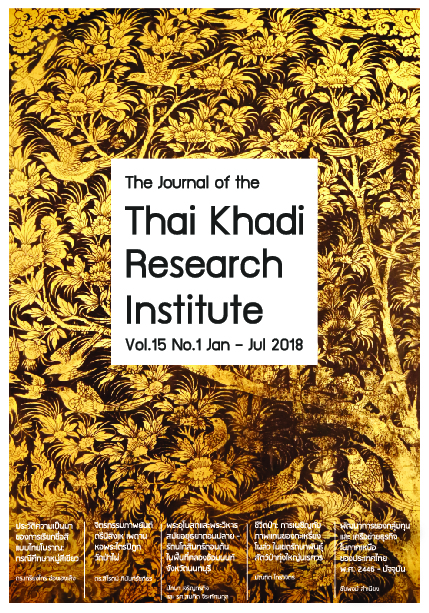Wildlife: Representation of the Pow Karen in Thungyai Naresuan Wildlife Sanctuary
Main Article Content
Abstract
This article presents the representation of the Pow Karen in Thungyai Naresuan Wildlife Sanctuary. The Pow Karen people have constructed their society based on their representation, legends, tales, narratives, and respect for spirits and nature. Through using methods of trans-species ethnography or multi-species ethnography, it is found that the Pow Karen come to define the term “beyond-human” from the standpoint of multi-species in the forest. Therefore, their culture and representation are constructed through an intersected mixture of their representation and viewpoints related to multi-/ trans-species. The author recommends that researchers switch from anthropocentrism, where human beings are seen as the central or most significant entity, to the Pow Karen’s approach where the viewpoints of animals, trees, stuffs, tools, etc. are deliberately taken into account.
Downloads
Article Details
There is no charge for paper processing and publication. Once the paper is under peer-review process, however, if the paper is withdrawn for any reason the author will be responsible for the expense of 3,000 Baht occurred in the review process.
References
Cadena, De La. (2010). Indigenous Cosmopolitics in The Andes: Conceptual Reflections beyond “Politics”. Cultural Anthropology, 25(2), 334 - 370.
Castro, De. (1992). From The Enemy's Point of View: Humanity and Divinity in an Amazonian Society. Chicago and London: The University of Chicago Press.
Descola, P. (1994). In the Society of Nature: a native ecology in Amazonia. Cambridge: Cambridge University Press.
_____. (2005). Ecology as Cosmological Analysis. In The Land Within Indigenous territory and the perception of environment, Edited by Surralles A. & Hierro, Pedo G. Copenhagen Denmark: IWGIA.
_____. (2013). The Ecology of Others. Chicago: Prickly Paradigm Press.
Duengkae, P., Maneerat, S., Khobkhet, O., Phatthanawiboon, A., Kanitthachat, P. & Kanphan, S. (2001). Kān plīanplǣng chanit khō̜ng nok bō̜riwēn phư̄nthī ʻopphayop rātsadō̜n ʻō̜k nai khēt raksā phan sat pā thung yai Narēsūan dān tawanʻō̜k [Changes in bird species in the area of migratory populations in the Thung Yai Naresuan Wildlife Sanctuary]. Thai Wildlife Journal, 11(1), 47 - 57.
Jr, John H. (2014). Aesop's Anthropology: A Multispecies Approach. Mineapolis: University Of Minnesota Press.
Kirksey, S. & Helmreich S. (2010). The Emergence of Multispecies Ethnography. Cultural Anthropology, 25(4), 545 - 576.
Kohn, E. (2013). How Forests Think: Toward an Anthropology Beyond the Human. Berkeley, Los Angeles and London: University of California Press.
Phrmmakul, P. (2003). Kānchai thin thī ʻāsai læ yư̄a khō̜ng sư̄akhrōng nai khēt raksā phan sat pā thung yai Narēsūan dān tawanʻō̜k [Use of habitat and tiger prey in Thung Yai Naresuan Wildlife Sanctuary on the east]. Thai Wildlife Journal, 11(1), 1 - 12.
Shir-Vertesh, D. (2012). “Flexible Personhood”: Loving Animals as Family Members in Israel. American Anthropologist, 114(3), 420 - 432.
Steinmetz, R. & Mather R. (1999). Impact of Villages on the Fauna of Thung Yai Naresuan Wildlife Sanctuary: A Participatory Research Project. Siam Society, 44, 23 - 40.
Steinmetz, R., Srirattanaporn S., Mor-Tip J. & Seuaturien N. (2014). Can community outreach alleviate poaching pressure and recover wildlife in South - East Asian protected areas?. Journal of Applied Ecology, 51(6), 1469 - 1478.
ThaiPBS. (2017). Pœ̄t hēt čhūngčhai “phrān” niyom lā sư̄a nai thung yai Narēsūan - Hūaikhākhǣng [Reveal to motivation of “the hunters” Tiger hunting in Thung Yai Naresuan - Huai Kha Khang]. Retrieved June 29, 2017, from http://news.thaipbs.or.th/content/176595.
Thuakthao, V., Sukmaswrong, R. & Phatthanawiboon, A. (2015). Khwām chukchum læ kānchai phư̄nthī ʻāsai khō̜ng somset (Tapirus indicus) nai khēt raksā satpāhūaikhākhǣng [Abundance and use of tapir living areas In Huai Kha Khaeng Wildlife Sanctuary]. Thai Wildlife Journal, 22(1), 71 - 79.
Tsing, A. (2015). The Mushroom at the End of the World: On the Possibility of Life in Capitalist Ruins. Princeton and Oxford: Princeton University Press.
Interviewees:
Booncho (alias). Villager of Ban Kong Mong Tha.
Hmong Thu-au (alias). Bann Wajukhu.
Jaa (alias). Ban Jakae.
La-mere (alias). Bann Thi Lai Pa.
Tha (alias). Bann Jakae.


